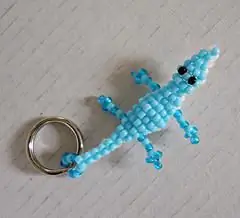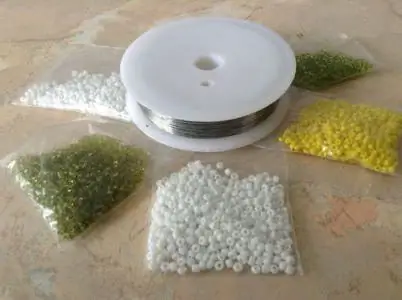
Inhaltsverzeichnis:
- Autor Sierra Becker [email protected].
- Public 2024-02-26 04:43.
- Zuletzt bearbeitet 2025-01-22 22:11.
Es gibt mehrere Namen für die Blume, die wir zum Weben aus Perlen anbieten möchten: syrische oder chinesische Rose, Ketmia, Hibiskus, venezianische Malve. Wir sind es gewohnt, diese Blume Hibiskus zu nennen. Klein, zerbrechlich, zart - es zieht die meisten Gärtner an.
Hibiskus blüht am häufigsten auf der Straße und erfreut das Auge nur einen Monat lang. Geschickte Nadelfrauen bieten an, aus Perlen ihren eigenen Hibiskus zu weben, der mit seinen zarten, dünnen Blüten das ganze Jahr über das Haus schmückt.
Wir präsentieren Ihnen die Meisterklasse "Hibiskus aus Perlen", versuchen Sie mit uns, mit Ihren eigenen Händen eine üppige Blume in einem Topf zu schaffen.

Material
Um dieses Handwerk herzustellen, benötigen Sie:
- 100g rote Perlen;
- 80g grüne Perlen;
- 10g gelbe Perlen;
- Draht 0,8mm;
- Draht 0,4mm;
- Draht 0,3mm;
- grüne Zahnseide oder Satinband;
- Topf;
- Gips.
Wählen Sie auch für die Kompositionverschiedene dekorative Elemente. Es kann Kunstrasen, Sisal sein. Farbe, einschließlich Aquarell, passt perfekt auf Gips. Sie können die Komposition auch mit Steinen und anderen handgefertigten Dekorationselementen dekorieren.

Blumenflechten
Fangen wir an, Hibiskus aus Perlen zu machen. Der Meisterkurs beginnt mit dem Flechten einer Blume und dem Kennenlernen einer der Perlentechniken.
Diese Technik hat mehrere Namen, aber die häufigsten sind Weben um die Achse und kreisförmig. Wir erklären Ihnen Schritt für Schritt, wie Sie ein Blütenblatt für eine Blume weben. Messen Sie dazu ein 0,4 mm dickes, ca. 1 m langes Stück Draht ab, treten Sie etwa 10 cm vom Rand des Segments zurück, f alten Sie den Draht in der Mitte und drehen Sie die Enden mehrmals miteinander, sodass eine kleine Schlaufe entsteht.
Dann geben Sie auf der Achse, dh dem kurzen Ende des Drahtes, 11 rote Perlen ein, am zweiten Ende - etwas mehr, damit der Draht, wenn er entlang der Achse gef altet wird, etwas hervorsteht. Wickeln Sie das lange Ende einmal um die Achse und nehmen Sie die Perlen wieder auf, wieder ein paar mehr Perlen. Machen Sie dasselbe am anderen Ende, sodass Sie einen Kreis erh alten. Machen Sie 4 volle Umdrehungen um die Achse und werfen Sie den Draht so.
Als nächstes weben Sie Nelken in die Blütenblätter. Dazu führen wir den Draht unter dem oberen Bogen hindurch und lassen Platz für 11 Perlen an der Achse. Gehen wir zurück, heben die Perlen auf, machen dasselbe auf der anderen Seite. Lass uns die Aktion wiederholen, aber das Ende nicht um 5 Perlen erreichen.
Das Blütenblatt ist fertig.
Für eine Blume davon werden 5 Stück benötigt. Schön zu gest altenWeben Sie die richtige Menge eines üppigen Blumenstraußes.
Damit die ganze Komposition wie eine echte aussieht, machen Sie einige Blütenblätter ohne Nelken, drehen Sie sie zu einer Röhre - auf diese Weise erh alten Sie kleine, ungeöffnete Knospen.
Weben Sie auf genau die gleiche Weise für eine Blume und Blätter, indem Sie die Achse etwas länger machen, um etwa 10-15 Perlen. Blätter sind besser, um verschiedene Größen zu machen. Für jede Blume benötigen Sie mindestens 3-5 davon.

Staubblätter
Nun nehmen wir die Staubblätter, der Hibiskus hat leuchtende Farben, also nehmen wir etwas Gelb und Rot. Wir messen ein Stück Draht 0,3 mm ca. 30 cm. Wir sammeln 25 rote Perlen darauf, treten ca. 10 cm vom Rand zurück. Wir machen eine Schlaufe aus 5 Perlen, indem wir einfach die beiden Enden um ca. 1 cm Länge zusammendrehen. Wenn Sie vom Weben ein wenig zurücktreten, sollten Sie dasselbe mit den nächsten fünf Perlen und mit der nächsten tun. Drehe alle 25 Perlen auf diese Weise und erh alte 5 rote Schleifen.
Füge die beiden Enden zusammen und fädle 5 rote Perlen auf. Spreizen Sie die Enden zu den Seiten und wählen Sie 20 gelbe Perlen auf einer langen. Machen Sie 4 weitere Schleifen auf die gleiche Weise wie die roten. Die Enden wieder verbinden und 2 rote anschlagen. Dann machen Sie 3-4 weitere Schleifen. Insgesamt werden drei Reihen gelber Staubblätter benötigt.
Spreizen Sie den Draht zum Schluss wieder zu den Seiten und wählen Sie an jedem Ende 20 rote Perlen. Drehen Sie sie so, dass Sie ein Flagellum erh alten. Drehen Sie die Enden des Drahtes fest zusammen, damit die Struktur nicht aufblüht.

Blumen sammeln
Jetzt lass uns den Hibiskus aus Perlen zusammensetzen. Fügen Sie dazu 5 Blütenblätter zusammen, legen Sie ein Gewebe mit einem Staubblatt in die Mitte, drehen Sie den Draht zusammen, legen Sie einen dicken Draht, um die Blume zu stabilisieren, und richten Sie die Blütenblätter vorsichtig aus. Nehmen Sie einen Zahnseidefaden oder ein Satinband. Von Beginn des Webens an fangen wir an, den Draht damit zu umwickeln. Lassen Sie 3-3,5 cm fallen, befestigen Sie einige Blätter am Gewebe, drehen Sie sie mit Draht und wickeln Sie sie weiter.
Gips nach Anleitung in einem Topf verdünnen, Blume hineinlegen, mit improvisierten Mitteln fixieren, damit der Perlen-Hibiskus nicht herunterfällt, während er in unschöner Pose friert.
Wenn das Produkt getrocknet ist, verzieren Sie den weißen Putz und bringen Sie ihn an einer prominenten Stelle an. Wir sind sicher, dass perlenbesetzte Hibiskusblüten die Aufmerksamkeit Ihrer Gäste auf sich ziehen werden.
Empfohlen:
Anthurien aus Perlen weben: eine Meisterklasse und ein Schema zum Weben von Blumen

Anthurie wird aufgrund des ungewöhnlichen Aussehens ihres Kolbens und der ursprünglichen „Decke“in Form eines Blütenblatts auch Blütenschweif genannt. Diese interessante Blume wird selten aus Perlen gewebt, aber das Ergebnis ist einfach erstaunlich
Wie macht man ein Krokodil aus Perlen? Volumensicken. Schema eines Krokodils aus Perlen

In diesem Artikel werden wir uns überlegen, wie man aus Perlen ein Krokodil macht - ein originelles Souvenir. Es gibt viele Möglichkeiten für seine Herstellung. Der Artikel wird volumetrische Perlenarbeiten beschreiben, da jeder weiß, dass solche Figuren interessanter sind
Wie erstelle ich eine Tulpe mit Perlen? Tulpen aus Perlen weben für Anfänger

Tulpen sind wunderschöne Frühlingsblumen, die zartesten und weiblichsten. Mit ihnen ist für die Mehrheit der schönen Hälfte der Menschheit der wunderbare Feiertag des 8. März verbunden. Tulpen blühen im frühen Frühling, um alle Mädchen zu erfreuen. Heute verraten wir Ihnen, wie Sie das ganze Jahr über schöne Pflanzen in Ihrer Wohnung zum Blühen bringen. Dazu müssen Sie nur lernen, wie man eine Tulpe aus Perlen webt. Ein Strauß dieser Frühlingsblumen wird eine großartige Dekoration für Ihre Küche oder Ihr Badezimmer sein
Eier mit Perlen: eine Meisterklasse für Anfänger. Weben aus Perlen

Perlen ist eine subtile Wissenschaft, aber nicht kompliziert. Hier sind Ausdauer und Liebe zur handwerklichen Kreativität wichtiger. Das resultierende Kunsthandwerk zeichnet sich durch erstaunliche Feinheit und Feinheit aus. Möchten Sie lernen, wie man Eier aus Perlen webt? Eine Meisterklasse für Anfänger hilft dabei
Wie man Blumen aus Perlen webt: Diagramme, Fotos für Anfänger. Wie man Bäume und Blumen aus Perlen webt?

Perlenarbeiten, die von akribischen Nadelfrauen geschaffen wurden, haben noch niemanden gleichgültig gelassen. Es braucht viel Zeit, um Innendekorationen zu machen. Wenn Sie sich also für eine davon entscheiden, lernen Sie von einfachen, um die Grundprinzipien des Webens von Blumen aus Perlen zu beherrschen
